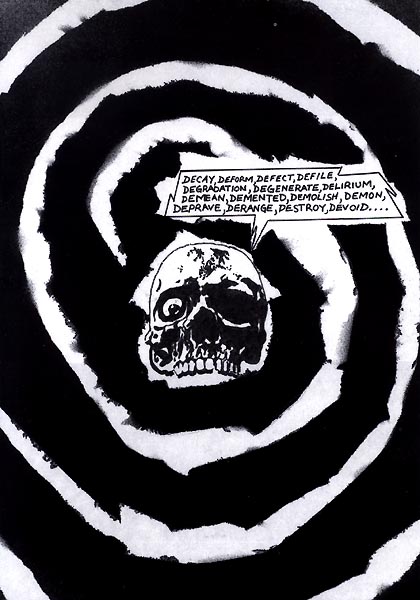View current page
...more recent posts

Artist Bill Schwarz, who knew the late painter Steven Parrino well, posts some thoughts and corrections of the newsprint accounts of Parrino's life and untimely passing here. One thing's sure: if Roberta Smith of the New York Times doesn't like your work, you'd be very lucky not to have her write your obit. Her tribute is how shall we say...affectless? merely descriptive? The closest it comes to a value judgment is saying the work had a "relentless if oddly energetic punk nihilism," a collection of adjectives and adverbs that give off a nice crackle but probably cancel each other out. The New York Post obit supplied the info that Parrino was "a little bit of a loner" who "didn't like crowds or parties." The police told a friend of Parrino's they believe that his motorcycle hit a pothole on Kent Ave., just a block away from his studio. In other words, an accident that could happen to anybody, especially with New York sized potholes. Yet by saying he "lost control" of his cycle "returning from a New Year's Eve party in Williamsburg," Smith creates the clear implication that...well, what does that imply to you? A journalist can be perfectly factual and still smear through the omission of detail. Thus are "bad boy" legends born, one supposes.
Bill says: "Parrino's destruction of unsold paintings has a wholly different meaning from the destructive editing activities of precedential modernists like de Kooning and Baldessari." He doesn't elaborate, but I think what he's talking about was, Baldessari famously destroyed his early, painterly paintings before embarking on his career as a conceptualist, but it's a fair guess he hasn't destroyed much since then. Whereas Parrino constantly cannibalized unsold work to make new--it was evident right there in the rubble pile at your feet. This was a very cool thing. I had a hard time with the "signature" canvases conspicuously torn off the stretcher, wadded up, and rehung--they seemed angry about something not worth getting angry about, which is to say, painting on canvas. (I'm open to having my mind changed by a retrospective.) He did do some beautiful paintings in that style, though (see above) and his career commitment to The Dark Side in his video, music and zine-making was likewise exquisite. I remember he organized some event nights at Team that included a screening of Dario Argento's Suspiria and also introduced Shell to the art world. Also very cool.
He will be missed, New York Times notwithstanding.

Writing about the black conservative columnist on the take from the Bush government to flak "No Child Left Behind," blogger Steve Gilliard, who is black, referred to the man as a "tom," meaning Uncle Tom. The people at the National Review, thinking they had a gotcha moment and had found a white lefty being racist, criticized Gilliard and steered many internet trolls his way. Gilliard, who has one of the sharpest tongues in the world of letters (see, e.g., his complete dismantling of Giuliani stooge Kerik), hit back hard, making merciless fun of the NR's googling skills and real, as opposed to trumped-up racism. Criticized by some that his harsh words don't "build dialogue" with conservatives (something this page gets, too) Gilliard responded:
I'm tired of people acting like these people can be reasoned with or talked to. They don't want to talk, they want to drive us away into a corner and ridicule our ideas.That's pretty much how I feel about people who voted for Bush last November, knowing what we all knew about how he lied us into war, approved torture as US policy (further endangering our soldiers), and unbalanced the budget to help rich cronies. The only dialogue I want to build with those voters is one where they say "I know, I fucked up, I'm sorry."
I'm not writing to make conservatives happy. I want them to hate my opinions. I'm not interested in debating them. I want to stop them.
Untitled (Charles Biederman)
2005, HTML, 500 x 460 pixels, by Chris Ashley
tedg, a great film critic of space and "folding," on Scorsese's The Aviator:
Martin Scorsese: My regular readers know that I have been very critical of his films. Sure, they are crafted well enough, but the world he created was not one worth visiting. His films until recently were of the Italian storytelling school which focuses on characters. Those characters do not inhabit their worlds as much as create them. Scorsese's camera, therefore, was affixed to people, almost by a visible thread.An earlier post on tedg is here.
But those of us who watch film seriously know that there is nothing but empty darkness just outside the camera's eye. There's no world, so there can be no God, or fate, or luck or whatever material you imagine fills the river of life. He knows it is a cheat as well and has said so. Just like many other fabulously successful filmmakers who know their work is hollow, in his later years he's tried to mature... to master a greater notion of creation.
"Gangs" was a success in this regard though an unfinished film because the Weinsteins pulled the plug. It marked a completely different approach to space and context, and I applauded it. Now he actually finishes a movie in the new style. Though this is a story of a man, it is no longer anchored to the man. The camera is now Orson Welles' camera with shots of the space with people in it. So obvious is some of this that when Hughes first retreats, he stays out [of] a room that inexplicably (and unhistorically) has strings tied from hither and yon from objects. Take another look at that room and see all of Scorsese's old camera angles. I think we can welcome Scorsese now as the best new filmmaker of the year. This is as much his story as Hughes'.
Cate Blanchett: Cate is one of three actresses alive who can fold her acting, meaning that she can simultaneously deliver two characters in the same motions. She's at the top of her game here (while Julianne is devolving with an apparently thick husband). Hepburn was an amazing actress, deeply untalented in the conventional measures but capable of engineering her surroundings to suit. Her engineering of the "Philadelphia Story" persona is Hollywood legend. She engineered a character that worked, then stepped into it. The old Scorsese would have hired someone like Streep to play Hepburn and lumbered around after her.
The new Scorsese allows Cate to flower and willingly supports the folding: an actress (Cate) playing a character (Kate) who is playing a character. You can see all the conduits of control, all the taut strings at two levels. God, what a great time to be alive!
Howard Hughes: The movie gave the impression that Howard simply inherited his money. No so. He was a brilliant engineer who famously codesigned systems and the engineering organizations to support them. While most of us were barfing at frat parties, he designed a drill bit (often credited to his father) that is still the standard in the industry, together with a set of screw connections that has since become the international standard. That's where the money came from. And though he went loopy toward the end, he ensured that 100% of his wealth (yes, all assets were sold) went to endow the world's largest private research institute.
This was a passionate engineer in a world of monopolistic thugs (Gates take notice), truly what we like to think the "free market" is all about. The movie also ignores a key movie connection: He always intended the "Spruce Goose" to be made of wood, and because all US manufacturing assets were committed, he designed a production system that allowed small businesses, even backyard groups, to make pieces that would be floated down rivers and successively be glued into larger parts. This (what he called the "packet production system") was the first serious research into what we today call "virtual enterprises."
When the war ended, he sent his virtual enterprise experts into his film business where they used the system (freely giving away details) to destroy the vertically integrated studio system. Nearly all movies today use his virtual enterprise approach and the Weinsteins (producers of this very film) are the current masters of the system.
